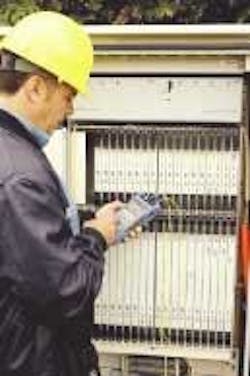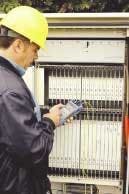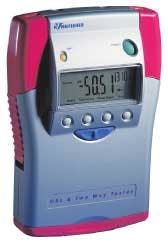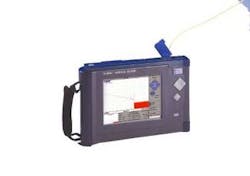Test vendors revel in FTTP opportunity
No one is more excited about the recent buzz surrounding the deployment of fiber to the premises (FTTP) technology than test equipment vendors, which see a very real opportunity to equip tens of thousands of technicians with portable devices tailored to FTTP applications. There’s nothing particularly revolutionary about the equipment. But the potential volumes lead one vendor to declare this “the most exciting time in the history of fiber optics.”
The three basic measurements for PON-based FTTP networks are power, loss, and optical return loss (ORL). Such measurements require the most commonly used tool, which typically combines a handheld power meter, source, and ORL device. The ORL measurement is particularly critical in the delivery of the video portion of triple-play services, reports Benoit Masson, senior product manager at EXFO (Quebec City). “Verizon is considering delivering both analog and digital services, and the analog signal is very sensitive to backreflections. If you don’t pay attention to that, you could get ghost reflections and other kinds of interference,” he says.The typical power meter is a broad-range detector, measuring all of the optical power regardless of the wavelength. But PON configurations employ three wavelengths-two downstream at 1490 and 1550 nm and one upstream at 1310 nm-making it necessary to develop a power meter that will separate each wavelength via a different filter and detector. EXFO has a new handheld device, for example, that enables technicians to measure all three wavelengths simultaneously to determine whether the optical power levels of each wavelength are within the acceptable range. Handheld devices from Agilent Technologies, Acterna, Sunrise Telecom, Kingfisher International, and Digital Lightwave provide similar pass/fail indicators.
Ease-of-use has become important because many of the technicians using the devices are former POTS technicians. Today’s technician is “going from copper to triple-play,” explains Peter Schweiger, business development manager at Agilent (Palo Alto, CA). “He’s going from megahertz or in some cases kilohertz to terahertz, which is where light starts. He’s going from dial tone, and now all of a sudden, he has to troubleshoot a digital set-top box on video. You are starting to hear the term ‘fiber tech.’ It’s a new job classification.” These new fiber technicians require tools that are less complicated and more intuitive than existing equipment.
More complicated testing is sometimes necessary, however. “Our experience with customers has shown that service providers initially assumed that simple power meter tests would be sufficient for maintenance purposes. But there have been more problems than expected with optical cables and more maintenance than expected,” reports Jack Landau, marketing communications manager at Anritsu (Richardson, TX). “Finding the exact location of fiber breaks or other problems using simple power-meter tests has turned out to be too time-consuming, sometimes taking several hours to locate a fault.”
The solution, he says, is a specially designed optical time domain reflectometer (OTDR). Unlike the basic handheld optical loss test set, which characterizes the overall loss of the entire link, an OTDR enables users to characterize each network element in the link. However, the traditional OTDR is not adequate for FTTP applications; in fact, the required functionality of even an FTTP-specific OTDR changes depending on how the device is used.According to EXFO’s Masson, the typical RBOC strategy employs an OTDR to test from the central office (CO) to the splitter, then from the splitter to the drop terminal or optical-network terminal (ONT), which is close to the home. In this scenario, the OTDR does not have to test through the splitter itself. But the rural or smaller independent operators often test from the CO to the drop terminal and vice versa, right through the splitter. The typical splitter has 1×16 or 1×32 ports. “If you test through a 1×32-port splitter, you have a loss of 18 dB, so a normal OTDR with standard analysis software has a very difficult time testing the link,” admits Masson.
Moreover, the traditional OTDR has a long dead zone of 8-10 m, but OTDRs tailored to FTTP applications must feature a dead zone in the neighborhood of 1-2 m or less. A dead zone appears after an “optical event,” like a splice, splitter, connector, or coupler. The optical event reflects a certain amount of light back to the OTDR, temporarily blinding the OTDR’s receiver. “If you are looking for a problem that typically occurs near the coupler, the conventional OTDR would mask such a problem because it would be within the same zone as the coupler; you wouldn’t be able to distinguish between the coupler and some other problem that was near it,” explains Landau. A smaller dead zone provides better resolution over shorter fiber links like those found in FTTP networks.
Agilent recently unveiled a mini-OTDR, the E60003C, for FTTP applications that features a 1.5-m dead zone as well as 43-dB dynamic range, which enables users to test through the splitter. “It allows the customer to do what they need to do with one button,” explains Schweiger, “whether it’s finding a break that is several feet away or testing from the central office to the house to see which leg there’s a break on.”
Anritsu has also introduced an FTTP-specific device, the AccessMaster MT9080, which includes the OTDR function plus a visible laser diode that generates a wavelength that can be seen with the human eye. The visible light source enables the less experienced technician to do a “gross check of the fiber,” says Landau. “As a rough guide, someone could just look at the fiber to see if there is any light in it, but this is not the kind of check that would be made on sophisticated long-distance fiber.”All the test equipment vendors interviewed here admit that the technical challenges presented by FTTP and PON networks are not insurmountable; it’s the challenge of hitting the right price points that has these vendors scrambling. “We have to provide tools that are low-cost, or it just won’t fly,” says Schweiger. “When an RBOC says, ‘Okay, I want to deploy fiber to the home,’ if they have to outfit every one of their guys with $10,000 worth of equipment, their business model collapses.” A traditional OTDR alone sells for around $10,000, but OTDRs designed for FTTP applications are selling in the $4,000 to $5,000 range. Handheld power meters are selling for hundreds of dollars instead of thousands.
While this may indeed be an exciting time for test equipment vendors, it is also an uncertain time. “One of the challenges on the test side is just looking at all the changes that are going on as the service providers look at their business case and how they are going to roll out these networks,” reports Jerry Gentile, general manager of the Telecom Field Services Group at Acterna (Germantown, MD). “Both SBC and Verizon have talked about implementing fiber universally for brownfield and greenfield build-outs. SBC seems like it has retraced steps a little bit and is switching toward VDSL for their brownfield applications and then doing fiber in the new ones. At least, that is the current talk.”
If there’s one fact upon which all the test equipment vendors seem to agree, it’s that there’s been a lot of talk about FTTP technology and a very sudden ramp-up in deployment. As a result, test equipment vendors are developing more intimate relationships with their customers, whether they are RBOCs or rural independent operators. “What you’ll see is that maybe the products that are here now aren’t the products that will be here in five years,” contends Schweiger. “There are no standards for testing [FTTP networks]. There are no recommendations, no de facto standards.” The test equipment vendors “who work most closely with the customers and service providers will come up with the most innovative, perfect fit, but it isn’t there yet,” he says.
Schweiger believes today’s basic tools will be augmented in the future by “more intelligent tools that take you from outside the house into the home.” The newly minted fiber technician will need more sophisticated tools to troubleshoot not just the signal, but the services themselves. And Acterna’s Gentile agrees. “In five years, you will probably see some fairly targeted products toward PON technology-if it really flies,” he muses. “I think that is still a question mark on a lot of people’s minds: How far is this going to go?”


